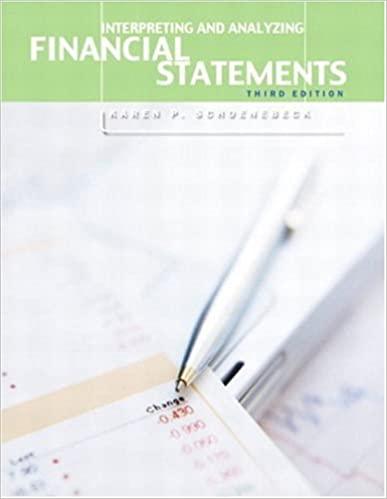Question
3 . On July 1, 2018, Tony and Suzie organize their new company as a corporation, Great Adventures Inc. The following transactions occur from August
3 . On July 1, 2018, Tony and Suzie organize their new company as a corporation, Great Adventures Inc. The following transactions occur from August 1 through December 31. Also, the balances are provided for the month ended July 31. The articles of incorporation state that the corporation will sell 20,000 shares of common stock for $1 each. Each share of stock represents a unit of ownership. Tony and Suzie will act as co-presidents of the company. The following business activities occur during July for Great Adventures. Jul. 1 Sell $10,000 of common stock to Suzie. Jul. 1 Sell $10,000 of common stock to Tony. Jul. 1 Purchase a one-year insurance policy for $5,880 ($490 per month) to cover injuries to participants during outdoor clinics. Jul. 2 Pay legal fees of $1,100 associated with incorporation. Jul. 4 Purchase office supplies of $1,500 on account. Jul. 7 Pay for advertising of $330 to a local newspaper for an upcoming mountain biking clinic to be held on July 15. Attendees will be charged $40 the day of the clinic. Jul. 8 Purchase 10 mountain bikes, paying $11,900 cash. Jul. 15 On the day of the clinic, Great Adventures receives cash of $2,000 from 50 bikers. Tony conducts the mountain biking clinic. Jul. 22 Because of the success of the first mountain biking clinic, Tony holds another mountain biking clinic and the company receives $2,450. Jul. 24 Pay for advertising of $820 to a local radio station for a kayaking clinic to be held on August 10. Attendees can pay $100 in advance or $150 on the day of the clinic. Jul. 30 Great Adventures receives cash of $7,000 in advance from 70 kayakers for the upcoming kayak clinic. Aug. 1 Great Adventures obtains a $33,000 low-interest loan for the company from the city council, which has recently passed an initiative encouraging business development related to outdoor activities. The loan is due in three years, and 6% annual interest is due each year on July 31. Aug. 4 The company purchases 14 kayaks, paying $16,800 cash. Aug. 10 Twenty additional kayakers pay $3,000 ($150 each), in addition to the $7,000 that was paid in advance on July 30, on the day of the clinic. Tony conducts the first kayak clinic. Aug. 17 Tony conducts a second kayak clinic, and the company receives $11,500 cash. Aug. 24 Office supplies of $1,500 purchased on July 4 are paid in full. Sep. 1 To provide better storage of mountain bikes and kayaks when not in use, the company rents a storage shed, purchasing a one-year rental policy for $3,120 ($260 per month). Sep. 21 Tony conducts a rock-climbing clinic. The company receives $15,000 cash. Oct. 17 Tony conducts an orienteering clinic. Participants practice how to understand a topographical map, read an altimeter, use a compass, and orient through heavily wooded areas. The company receives $18,000 cash. Dec. 1 Tony decides to hold the companys first adventure race on December 15. Four-person teams will race from checkpoint to checkpoint using a combination of mountain biking, kayaking, orienteering, trail running, and rock-climbing skills. The first team in each category to complete all checkpoints in order wins. The entry fee for each team is $550.Dec. 5 To help organize and promote the race, Tony hires his college roommate, Victor. Victor will be paid $30 in salary for each team that competes in the race. His salary will be paid after the race.Dec. 8 The company pays $1,600 to purchase a permit from a state park where the race will be held. The amount is recorded as a miscellaneous expense.Dec. 12 The company purchases racing supplies for $2,600 on account due in 30 days. Supplies include trophies for the top-finishing teams in each category, promotional shirts, snack foods and drinks for participants, and field markers to prepare the racecourse.Dec. 15 The company receives $22,000 cash from a total of forty teams, and the race is held.Dec. 16 The company pays Victors salary of $1,200. Dec. 31 The company pays a dividend of $3,800 ($1,900 to Tony and $1,900 to Suzie). Dec. 31 Using his personal money, Tony purchases a diamond ring for $4,200. Tony surprises Suzie by proposing that they get married. Suzie accepts and they get married!
The following information relates to year-end adjusting entries as of December 31, 2018. a. Depreciation of the mountain bikes purchased on July 8 and kayaks purchased on August 4 totals $8,500. b. Six months worth of insurance has expired. c. Four months worth of rent has expired. d. Of the $1,500 of office supplies purchased on July 4, $230 remains. e. Interest expense on the $33,000 loan obtained from the city council on August 1 should be recorded. f. Of the $2,600 of racing supplies purchased on December 12, $170 remains. g. Suzie calculates that the company owes $13,400 in income taxes. Assume the following ending balances for the month of July.'

3. Post transactions from August 1 through December 31 and adjusting entries on December 31 to T-accounts. (Be sure to include beginning balances in the T-accounts.)



Step by Step Solution
There are 3 Steps involved in it
Step: 1

Get Instant Access to Expert-Tailored Solutions
See step-by-step solutions with expert insights and AI powered tools for academic success
Step: 2

Step: 3

Ace Your Homework with AI
Get the answers you need in no time with our AI-driven, step-by-step assistance
Get Started


